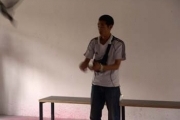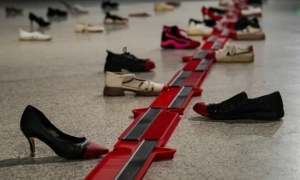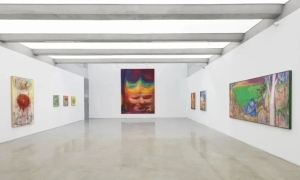自6月25日西安文献展在纺织城开幕以后,岳路平的计划是每两周做一次展览。但是在展览开幕的第二天,马清运的到来打乱了这个“计划”。他建议西安纺织城艺术区加入深圳双年展,与此同时,他决定加入纺织城艺术区。连带着纺织城艺术区其他大量无法事先得到评估的因素,西安文献展进入一个不断被“调停”,同时也成为调停者的状态。
马清运说,“……在先锋的姿态之外,建筑师有另一种可能是在调停中去对应社会。”作为2007深圳双年展的策展人,我们不知道他分别在洛杉机、上海、深圳等地在什么时间、在哪种环境、进行了哪种方式的调停,我们只是以盲人摸象的局面在西安纺织城“再现”深圳双年展。也许在未来,深圳双年展也会以同样的方式“再现”西安纺织城艺术区。
“自助参”的起因是要在西安文献展上“回顾”西安一个曾经十分活跃的学术沙龙,西安文献展策展人岳路平希望这个沙龙的发起者之一张瑞既“介入”纺织城艺术区,又“介入”西安文献展。西安文献展开幕展在纺织城艺术区A区进行之后,希望文献展扩大规模,展场不要局限在A区的声音不断出现。岳路平开始意识到这个“回顾”的模型可以扩大成为艺术区所以相关者交流、对话的一个平台。“自助参”的想法就这样被自然地孵化出来:组织者尽量聚合各种可能性,参与者在其中按需索取和贡献。
“自助参”接着开始组织所有能够在7月28日进行开放的工作室和空间,同时也邀请艺术区外,西安各个领域的活跃分子参加。
“自助参”的通知刚刚发出,思班都市的管理总监陈展辉说思班都市在蓝田的“玉山东西”的第二次展览也在“自助参”的同一天举行。岳路平立即建议把两个事件的时间错开,可以使两个活动交相辉映。
西安文献展之前一直没有任何经费来源,是靠艺术家凑钱来维持它艰难的运转。一个星期以前,思班艺术基金会(美国)决定赞助“自助参”。岳路平赶到上海跟思班艺术碰面。刚从美国回来的马清运临时决定把原先计划在蓝田进行的“深圳双年展”研讨会改在纺织城进行。所有之前已经编排好的序列又被打乱、重新组合。
因此,我们的通知几乎每天都在更新。目前我们只能大概描绘一下截止今天为止,我们可以预测的当天的情形:
28日早上九点,“自助参”展览开幕,讨论会开始,来自西安艺术、学术、设计、音乐等领域的活跃分子开始根据事先拟订的题目进行讨论。
11点半左右,马清运主持讨论;12点左右,自助餐开始;自助餐之后,马清运主持深圳双年展“城市再生”研讨会。整个过程中,嘉宾、记者、参与者会陆续到来(倒不是我们不想按部就班,只是因为我们讨论开始的时候,一些人还在空中飞行,另一些人正要上飞机)。
下午3点左右,大部分人会从纺织城出发,到蓝田去,进入另外一个现场……
附件1:“自助参”邀请函——西安文献展第二次展览
我们向你发出邀请:请你把你自己的东西(艺术或者非艺术)拿到这里来展示;我们向你发出邀请:请你参加7月28日上午9点开始——下午3点的不间断的讨论(艺术的或者非艺术的话题)。中午有自助餐。
Dear guest, we invite you to show your work (arts or else) here and to join the discussing on the topic you are interested in from 9 a.m to 3 p.m 28th July. We will provide buffet dinner.
我们采取自助餐的方式来组织这次展览,因为我们认为西安文献展是属于西安所有人的展览;我们有很大的艺术抱负:要在这次文献展上讨论中国当代艺术的真身,但是我们也相信“真身”实际上存在于任何一个真诚地对待自己和自身环境的个人,所以“你”永远是这次文献展讨论的主人。
We hold the exhibit in the form of buffet dinner. As we are convinced that XI’AN DOCUMENTA belongs to all Xian people. We have big ambition: that is we’d like to discuss the truth of China Contemporary Arts in this documenta .and we also believe the truth exist in the one who treat himself and its environment sincerely. You will be the host of the discussion.
原来我们“计划”每两周进行一次小展览,但是在推进的过程中,我们发现计划没有变化快。这种“无奈”实际上也是我们要追求和呈现的:我们要诚实地跟环境对话。
We planned to hold the exhibit once two weeks at first. However, in the process of the preparing we find it is hard to do it. And the change is also we need: face to the environment honestly
要展现你的作品、要担任讨论会的主持人(28日的讨论,我们计划大约每半个小时更换一位主持人),请通过这个E-MAIL联系我们:onwest@vip.sina.com
If you’d like to show your work and to be the host of the discussion (we’d like to change the host half an hour in the discussion on 28th), you can contact us via the E-mail: onwest@vip.sina.com
l 开放空间:纺织城艺术车间A区(董健工作室、王风华工作室、贺军工作室、何军工作室、白夜工作室、贾明工作室、钟国昌工作室、程乾宁工作室、祁逸工作室)
B区(纺织城-主场[苏涛+李彤工作室]、李江工作室、秦赞军工作室、罗瑞工作室、墨朗摄影工作室、石珩伯工作室);C区(陈晓春工作室);绳空间
Open Studio: A Zone of Art workshop in Textile City(Dong Jian Studio、Wang Fenghua Studio、He Jun workshop、He Jun Studio、Bai Ye Studio、Jia Ming Studio、Zhong Guochang Studio、Cheng Qianning Studio、Qi Yi Studio)
B Zone of Art Workshop in Textile City(Main field--Su Tao & Li Tong Studio、Li Jiang Studio、Qin Zanjun Studio、Luo Rui Studio、Mo Lang Photograph Studio、Shi Hengbo Studio)
C Zone of Art Workshop in Textile City (Chen Xiaochun Studio)
Rope Space
l 邀请的主持人及话题(更新中):苏中秋(是什么使今天的艺术如此有魅力,如此能挣钱?)、雷志忠(“影子-西安文献展第三次展览”发布)、张瑞、郭凤怡(我是郭凤怡)、李世豪(老碗面—在包容与包围之间)、苏涛(主场)、陈晓春(市场进取跟传统坚守的搏弈)、马清运(博物馆的都市化与都市的博物馆化)、宋群(本地—城市的另一种外壳)、张建川、贺军(噪音)、白夜(从酒开始,这里“现在”意味着什么?)、王风华(城市细节的视觉)、贺小强(西安音乐的路与墙)、陈怡(柏林童话)……
the host and the topic (updating): Su Zhongqiu (What make the arts so charming and profitable today)、Lei Zhizhong (the release of “the 3rd XI’AN DOCUMENTA-shadow)、Zhang Rui、 Guo Fengyi(I’m Guo Fengyi)、Li Shihao(the old bowl noodle – between the contain and surrounding)、Su Tao(Main Field)、Chen Xiaochun ( the negotiation between the marketing spurt and traditional preserve)、 Ma Qingyun(the urbanization of the museum and the museumization of the urban)、Song Qun(Local--another shell of the city)、Zhang Jianchuan、He Jun(Noisy)、Bai Ye(Start from the wine ,What does it mean by “now” ?)、Wang Fenghua(the view of the city’s detail )、He Xiaoqiang (the road and wall of the XiAn’s music)、Chen YI(the fairy of the Berlin) etc.
l 参展作品清单(更新中):马达思班(两个设计案例:好想法如何表达并且成为好设计和好建筑)、张晓明《客场》、苏中秋(互动绘画《是什么使今天的艺术如此有魅力,如此能挣钱?》)、程乾宁《2号坑》、李世豪《老碗面》、席红哲图片作品、雷艳平《无题》、分水领俱乐部计划、Sigal M. Buseel作品(美国)
the list of the show work (updating): MADASPAM(two design example: How can a good idea to be a good design and architecture)、Zhang Xiaoming (To be a guest)、Su Zhongqiu(the interact drawing < What make the arts so charming and profitable today >)、Chen Qianning(pit 2)、Li Shi hao(the old bowl noodle)、the picture work of Xi Hong Zhe、Lei Yanping(no title)、the plan for watershed club、the work of Sigal M. Buseel(US)
l 特别通知:12点,“深圳城市/建筑双年展”研讨会
主题:城市再生 主持:马清运(著名建筑师/深圳双年展策展人)
Notice: the symposium of “2007 Shenzhen Biennial of Urbanism and architecture” 12 a.m
Topic: City of expiration and regeneration-“CoER”
Host : Ma Qingyuan(the famous architect/Curator of the Biennial of Shenzhen)
策展人:岳路平
策展助理:姚子 分水岭俱乐部
视觉:孟坤 席红哲 王基宇 王莹 姜延
赞助:思班艺术基金会(美国)
媒体支持:东方视觉 CFX
展览预约电话:(029)87713866
赞助联系电话:13772158883
地点:西安市 纺织城 纺西路 238号 唐华一印(原西北第一印染厂)
Curator:Yue Luping
the assistant Curator: Yao Zi、Watershed Club
Visual: Meng Kun、Xi Hongzhe、Wang Jiyun、WangYing、Jiangyan
Website: www.onwest.com
Sponsorship: SPAMART Foundation(US)
Media Support: IONLY 、CFX
Booking: (029)87713866
Sponsor Contact: 13772158883
Add:Tang Hua Yi Yin ,No.238 ,FangXi Road, Textile City, Xi’an
另:由西安美术学院和思班都市主办,玉山酒庄承办的第二届“‘玉山东西’展”开幕式兹定于2007年7月28日16:00在西安市蓝田县玉山镇玉山酒庄展厅举行,我们的讨论会结束以后,思班都市有专车(座位有限)前往蓝田展览现场,我们谨此诚邀请您也参加蓝田展览和活动。
PS: the opening ceremony of the 2nd “YuShanDongXi” hosted by Xi’An Academy of Arts and Siban will be held at 4 p.m ,28th July 2007,in the hall in Jade Valley,YuShan town,LanTian county, Xi’An city. There will be a bus to take you to the hall after the discussion, we sincerely to invite you to the exhibit and other activities in LanTian.
蓝田展览将展出西安美院对窑洞和新农村题材,一个村庄的研究成果,并同时展出06届学生的专业绘画和装置创作。由蓝田玉山酒庄(Jade Valley)协办,为期14天。
The achievement of a study on the new village by the Xi’An Academy of Arts will be exhibited in LanTian. And at the same time there will also be displayed painting and design work by students. It will be run for 14 days co-operated by Jade Valley
当天下午将由马清运先生亲自主持学术研讨会,主题为三农问题和城市再生等。展览会同时将举行红酒品鉴会,您还可以参观在建筑界广受关注的“玉山石柴”和玉山酒庄最新落成的精品酒店“井宇”。
Ma Qinyuan will host the symposium on the reborn of the ciy and problems facing agriculture, rural areas and farmers in the afternoon. A party for wine sampling tasting will be held at the same time. And you can also visit the “YuShanShiChai” which attract lots attention from the architecture field and the JingYu- a new wine store in Jade Valley
附件2,深圳双年展20070423 新闻通稿
2007年深圳城市/建筑双年展在确定了马清运作为独立策展人后,目前已经形成以马清运为核心,以深圳、上海、洛杉矶三点为据点的网状互动筹策团队。这样一个具有国际化特征、互动高效的工作团队本身成为本届双年展集思广益、交流沟通的核心枢纽,策展行为本身也将成为双年展的一个有机部分和重要特色,目的在于将城市市民与世界市民集中起来,挖掘城市的意义、珍惜城市的前景,通过不同媒介,达到互动共力的积聚能量。策展的思想与展出的内容具有同等重要价值,现阶段正在进行的工作包括:双年展的出版工作流程及合作支持团队、策展人特约委托调研课题方向、外围展主题策划以及城市建筑项目。
出版媒体工作作为本届双年展的一个重要特色部分,计划通过出版的形式记录双年展的整个过程以及探讨大范围思想聚集的可能性。目前我们已经初步商定由多位国内外艺术家组成的视觉设计团队以及大范围专业媒体合作单位,在展览形式和空间设计概念上我们也提出了“图书超市”、互动媒体等创新概念。高质高量的出版物将会成为本届双年展的成果结晶和思想运转的轨迹。
本届双年展提出“策展人委托研究课题”的想法,这一想法的提出旨在表明双年展不但要有作品,还要有研究,避免双年展流入平庸思想和陈旧展品集合的俗套。本届双年展不但是总结展示两年来的完成作品,更重要的是从两年来的思考中摄取、并发掘出新思想,启示新精神。目前拟定的研究课题已经超过20项,所有研究方向都是围绕双年展主题“城市过期与再生价值”所展开的讨论,包括国土所有权、土地开发价值,环境效能变化、生产力转化、生活质量的构成等内容。首要的研究人员也来自各个领域,涉及建筑、学术、艺术及媒体等专业。策展团队通过“策展人特约委托调研”的方式进行具体的研究观察。其研究成果将作为一种构建深圳双年展“公共面貌”的手段,通过对深圳城市的体验、研究和状态纪实而不断形成。这样做的延伸目标是使双年展的当地群体可以参与到和城市交错网络的对话中来,一场极具挑战性的、综合性的、振奋人心的对话。
为配合双年展主题,扩大影响力和辐射范围,与双年展同期举办的外围展将与深圳大学名牌专业建筑系合作,希望以长远的眼光关注超越建筑实用性的文化论题,共同关注深圳特质。一个城市的大学历来承担着城市思想的核心力量,目前策展工作组已经拟定外围展览策划书与深圳大学达成合作意向,中国壁画协会已经主动申请加入外围展专题展览研究部分。
目前,策展团队还策划了另一个亮点:在世界范围内策动尽可能多的,思考城市问题的专家研究者,对城市再生做各自的思考,形成策展人比参展人多的局面,也将是本届双年展的特色之一。本届双年展将在聚焦中国城市问题的基础上,将整个世界联成一个网络,通过百花齐放式的讨论世界不同城市的发展历程,探讨一种新型的共存城市,并通过社会、经济、宗教、政治等不同的思考角度启示建筑手段以外的方式来解除城市困扰。
附件3,西安文献展策展文案
影骨
前几天跟一位著名策展人聊即将开幕的威尼斯双年展和卡塞尔文献展,得知日本的一些策展人要联合亚洲其他一些策展人一起组织一个“影子展览”,来对抗威尼斯和卡塞尔的“霸权”。
我心里想,为什么我们成了“影子”?中国艺术家在威尼斯双年展的“中国馆”呈现的作品、中国艺术家在卡塞尔文献展上呈现的作品真的是“中国当代艺术”的“真身”吗?这些艺术“代表”的合法性是如何建立的?
这几年,当代艺术霸权的话题一直被拿来进行讨论,少数国外收藏家和少数国际重要双年展的文化权力跟国家文化机关的权力,时而单独生效、时而相互配合,产生了一批中国当代艺术寡头。十位数的这些寡头们垄断了国际双年展、收藏家等重要的艺术资源。
寡头艺术真的能够“代表”中国当代艺术吗?与此同时,类似于“影子展览”的想法与其说是在“对抗”,还不如说是在敲边鼓。
那些真正保持跟自身环境的真诚关系的艺术家和艺术品,才是真正的中国当代艺术的代表。为什么我们不把威尼斯双年展和卡塞尔文献展上的“艺术家”和“作品”看成真正的“影子”呢?
这种“反认他乡是故乡”的颠倒逻辑主宰了我们的艺术生产和艺术批评很多年了。它的结果是,当代中国人根本看不懂“中国当代艺术”和“当代艺术批评文章”。关于消费影响生产、批评成为吹捧的论述实际上已经很多很多,不是一个多么高深的道理。但是为什么指鹿为马的时代仍然没有结束?
关于“影子展览”的讨论,让我联想到西安附近法门寺的“影骨”:在发现藏在法门寺地宫的佛指舍利之前,一共发现了3件仿制的“佛指”。这三件仿制品后来被称为“影骨”,赵朴初用“一月映三江”来描述仿制品和真正的佛指(灵骨)之间的关系。
就此,我展开联想:中国艺术家、艺术品在世界三大展(卡塞尔文献展、威尼斯双年展和圣保罗双年展)上的表现实际上是“中国当代艺术”的三枚影骨;进而,中国艺术家、艺术品在亚洲的光州三年展、横滨三年展和台北双年展上的表现是“中国当代艺术”的第二个层次的“影骨”;进而,上海双年展、北京双年展和广州三年展在具备民意基础之前,仍然是中国当代艺术的第三个层次的“影骨”。
那么,“灵骨”在哪里?影骨已经提示了灵骨的形状、材质、大小等等信息,但是毕竟还不是真身。
“灵骨”在哪里?正是首届西安文献展的讨论目标。
Shadow relics
Several days ago when I talked about the forthcoming La Biennale di Venezia and Kassel Documenta with a curator, he told me that some Japanese curators would organize a “shadow exhibition” with other Asian colleagues to resist the “hegemony” of Venice Binary Exhibition and Kassel Document Exhibition. Why we became “shadows”? I said to myself. Could those Chinese artworks exhibited at Venice and Kassel truly represent “China’s contemporary art”? Are there any acceptable reasons for those artworks to acquire the high status?
The topic of “hegemony in contemporary arts” is a hot one in recent years. Sometimes do it singly and sometimes cooperate with each other, both a small group of foreign collectors together with the cultural authorities in a few important international Binary exhibitions and the State’s cultural departments, urged the emerging of a few “oligarchs” of China’s contemporary art. It is them who monopolized the important art’s resources such as international binary exhibitions and collectors
How could these “oligarchs in art” truly represent China’s contemporary art? At the same time, the ideas such as “shadow exhibitions” look like hollow propaganda more than the real resistance to the “hegemony” of Venice and Kassel exhibition.
Only those artists and artworks that keep a sincere close relationship to their soil could be said as the real representatives of China’s contemporary art. It is better to take the “artists” and “artworks” exhibited at Venice Binary Exhibition and Kassel Document exhibition to be “shallows”.
Many people worship and have blind faith in foreign things; such a kind of reverse way of thinking has been dominating our art production and criticism for many years. The result of it is that many Chinese could hardly understand the “China’s contemporary art” and “contemporary arts’ critic articles”. We have seen the analysis about consummation’s effects on production and how critics become praise for so many times, and it is not so difficult to understand this point. But why is this era of taking rubbish to be cream still far from its end?
The discussion about “shadow exhibition” makes me think about the “Shadow relics” (that are the mimics of Sacred Buddhist Remains). Three shadow relics were found in the underground palace of Fa Men Temple (close to Xi’an City), and later they were called “Ying Gu (shadow relics)”. Zhao Puchu, a master of Buddhism used a metaphor “one moon shining over three rivers” to describe the relationship between real finger relics and its shadow relics. So I make my mental association that the performances of Chinese artists and artworks at the three major art exhibitions (Venice Binary Exhibition, Saint Polo Binary Exhibition and Kassel Document Exhibition) are actually three “Shadow relics” of China’s contemporary art. The same reason, their performances at Gwangju Triennial, Yokohama Triennial and Taipei Binary Exhibition are “shadow relics” of the second level; and Shanghai Binary, Beijing Binary and Guangzhou Binary Exhibition are “Shadow relics” of the third level before they get the people’s hearts.
Where is the “real finger relics”? “Shadow relics” have already hinted the information as the form, material and size, but after all they could not replace the real one.
Where is the “real finger relics”? This is the main goal for holding the First Xi’an Document Exhibition.
纺织-防止-仿制
纺织城艺术车间的成立,是我们讨论“影骨”和“灵骨”的一个契机。建国初期建设的纺织城;2007年艺术车间对纺织城进行的“再生”处理;西安文献展跟卡塞尔文献展以及威尼斯双年展同时进行……给我们讨论中国当代艺术“真身”提供了一些有意思的话题。
纺织:专业的枷锁
建国初期,中国的社会主义建设基本上参考了苏联模式。无论是工业化还是教育,常常是根据专业来进行规划和设计。大学教育不再采用“通才”模式,而是采用“专才”模式。西安的东郊被规划为纺织城。
今天,过于专业化的教育和工业布局的弊端已经不断暴露,大学的合并、重组、对“通才”的重提,正在对之前的“偏执”进行纠偏。大量的老工业基地的废弃、改革、工人下岗、再就业等等状况提示着我们后遗症仍然存在。
艺术,也正在经历着对艺术教育制度、艺术创作的理论和材料基础、展示空间等的重新定义。
实际上,面对纺织城所折射的“专业化”以及“苏联模式社会主义”的后遗症,跟我们面对美术学院的“专业化”困境是同在一条历史反思纬线上面的。诸如“国画的现代化”、“油画的本土化”都不过是这个专业化困境中的子话题:如果我们无法走出这个专业化的困境,如果我们无法勇敢地面对“纺织城”的后遗症,我们也就没有讨论“中国当代艺术”真身的基础。
防止:隔离和迷惑
纺织城艺术车间的艺术家们为了艺术区的安全操了不少心,从艺术区的封闭式设计、门卫制度到艺术区与艺术区之间、艺术区与纺织厂之间、艺术区于区政府之间等等的关系,都做了很多“隔离”设计的工作。在艺术家的内心里面,也做出了、或者清晰了、强化了一些隔离工作。就像9层宝函守护着舍利,艺术家在内心里也在守护着他们的艺术理想、原则和立场、品位和尊严。一方面要跟一些东西告别,另一方面要跟未来的诸多诱惑保持距离。
“防止”话题也会组织参与西安文献展的艺术家、设计师、策展人、学者等通过讨论同时进行的威尼斯双年展和卡塞尔文献展的方式来讨论中国当代艺术的在“进取”和“保护”之间应有的态度。
影骨是对灵骨的保护,或者是通过迷惑来进行保护?这种联想方式有助于我们用一种相对简洁和具有象征意义的方式来厘清中国当代艺术跟西方文化、学术、艺术的关系;增加中国当代艺术的能见度;我们也会讨论文化遗产跟当代艺术的关系;甚至会在佛教影响中国和中国现代化进程之间进行对比。
仿制:弘扬或污染
这个话题希望把我们对与当代艺术的关怀延伸到对西安城市视觉生态的关怀上来。西安正在通过巨大的行政、财政以及文化资源让整个城市“再现盛唐雄风”。我们在一个巨大的唐景观公园大唐芙蓉园的高处可以看到,真古董(大雁塔)被规模宏大的假古董(唐风小区和唐风旅游建筑群等)包围着,显得孤立、无辜。
政府斥巨资在建设一个唐人街化和迪斯尼化的长安,当纪念碑逻辑和主题公园逻辑同时成立的时候,李白和白居易同时也充当了米老鼠和唐老鸭的角色。
假古董是在对真古董进行弘扬,还是进行污染?
仿制的话题并不局限在对城市视觉的关注。纺织城艺术车间跟西方流行的工业区改造成的艺术区之间的关系、跟798的关系,也是我们需要反思的。历史上的纺织城对苏联模式的仿制的得失也是我们需要回顾的。
Textile—Prevention—Imitation
The establishment of the Textile City art workshop offers us a chance to discuss “Shadow relics” and “real finger relics”. The Textile City was built in the early years of New China, the “regeneration” of it was given by the art workshop in 2007; the co-conduction of Xi’an Document Exhibition, the Kassel Document Exhibition and the Venice Binary Exhibition have offered us some interesting topics to discuss about the “real meaning” of Chinese contemporary art.
Textile: Fetters of Specialty
In the early years of new China, the Chinese socialist construction has been conducted mainly according to the patterns adopted by Soviet Union. Both industrialization and education have been programmed and designed on the basis of specialty. College education has adopted the “professional talent” pattern to replace the former “generalist” one. The east suburb of Xi’an has been planned as the Textile City.
Nowadays, the disadvantages of the over-specialized education and the industry layout have been gradually exposed; the combination, reconstruction of college and the reaffirmation of “generalist” are rectifying the former deviations. All these things such as the discarding of abundant former industrial bases, the reformation, the laying off of workers and the unemployment remind us the existence of aftereffect.
The concept of art is also being redefined in terms of its educational system, the theoretical and material basis of its creation and its exhibiting space. In fact, the “specialization” reflected by the Textile City and the aftereffect of “Soviet Union socialist pattern” is similar to the “specialization” predicament of the Fine Arts College. “The modernization of traditional Chinese painting” and “the localization of oil painting” are no more than the sub-topics of the specialization’s predicament. We will be incapable of talking about the real meaning of “Chinese contemporary art” if we cannot get rid of the predicament of specialization and face the aftereffect of “the textile city” courageously.
Prevention: Segregation and Puzzling
The artists in the art workshop of the Textile City have done a lot for the safety of the art area. A lot of “segregation” works have been done in the sealing-off designing of the art areas, the doorkeeper system, the relationship between different art areas, the relationship between art areas and textile factories, and the relationship between art areas and borough governments. The artists have also clarified and strengthened some segregation work. Just as the eight-layer box that protects the real finger relics, artists also have their own art ideals, principles, standpoints, tastes and dignities deep in their hearts. While leaving something, they also need to guard against some future temptations.
The topic of “prevention” will also make the artists, designers, exhibition organizers and scholars participating in Xi’an Document Exhibition show their attitudes towards the Chinese contemporary art. It also offered an opportunity for discussion “moving forward” and “protection”. Is the protection of “Shadow relics” to “real finger relics” done by puzzling? This kind of association will help us clarify the relationship between the Chinese contemporary art and the western culture, science and art in a relatively simple and symbolic manner, and enhance the visibility of the Chinese contemporary art. We will also discuss the relationship between the cultural heritage and the contemporary art; make a comparison between the influence of Buddhism on China and the progression of Chinese modernization.
Imitation: Promotion or Demotion
The topic draws our concern on the visual view of Xi’an City, which can be seen as the extension of our concern on modern arts. Xi’an has put enormous political, financial, and cultural resources to relive its “spirit in thriving Tang Dynasty”. On the top of “Tang Paradise”, we can see that the genuine curio (Wild Goose Pagoda), surrounded by massive forged ones (the Tang-style tour compounds), appears solitude and lonely.
The government has granted a large sum of money to build a Chang’an City in the style of China Town and Disney Land. When the monument logic and theme park logic coexist; Mick Mouse and Duck Donald will replace the roles of Li Bai and Bai Juyi, two great poets in Tang Dynasty.
Would the forged curios shed light on the genuine ones or become the eyesores?
Imitation is not only found in the out looking of the city. The relationship between Textile City art workshop and the arts’ ghettos rebuilt from industrial areas (the deal is popular in the West) should also be reflected as well as the relationship between the rebuilt and 798. We have drawn lessons from the imitation of Russian style Textile City already.
v

























